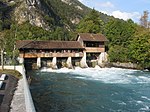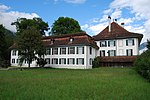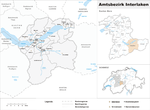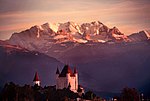Interlaken ship canal

The Interlaken ship canal (German: Interlaken Schiffskanal) is a 2.75-kilometre (1.71 mi) long canal in the Swiss canton of Bern. It connects Lake Thun with a quay in the town of Interlaken adjacent to Interlaken West railway station, thus allowing shipping services on the lake to serve the town and connect with railway services. It is still in regular use by the Lake Thun passenger ships of the BLS AG. The canal parallels the Aar river throughout its length. It has no locks and maintains the same water level as Lake Thun throughout. As a consequence, the water level of the canal at Interlaken West is significantly lower than that of the adjacent river and surrounding land. At the other side of Interlaken, the uppermost reach of the Interlaken section of the Aar river is used by the Lake Brienz passenger ships of the BLS AG to reach Interlaken Ost railway station. However there is no navigable connection between the two lakes, and in the 5.5 km (3.4 mi) between them the Aar river drops some 6 metres (20 ft), passing over several weirs.
Excerpt from the Wikipedia article Interlaken ship canal (License: CC BY-SA 3.0, Authors, Images).Interlaken ship canal
Fabrikstrasse,
Geographical coordinates (GPS) Address Nearby Places Show on map
Geographical coordinates (GPS)
| Latitude | Longitude |
|---|---|
| N 46.6827 ° | E 7.8506 ° |
Address
Interlaken West
Fabrikstrasse
3800
Bern, Switzerland
Open on Google Maps











